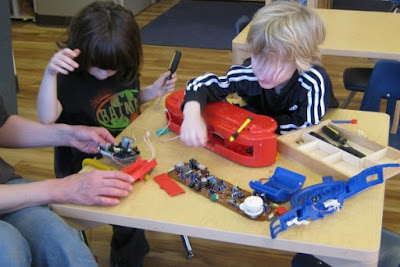Recently on a teacher discussion board I follow, some
teachers were discussing the new trend of “take apart” or “tinkering” centers
and how overwhelmed they felt trying to manage those activities in their
classrooms. “Take apart” isn’t actually a new trend, but the current push
toward emphasizing STEM (or STEAM or STREAM) activities has pushed the old
tools and woodworking activities into the spotlight. The teachers on this board
felt pushed to provide science and technology activities, but were struggling
with how to do it in a child-directed play based way that ensured children’s
safety. They were concerned about physical safety – children using tools like screwdrivers,
wrenches, and wirecutters safely. But also about emotional safety – one of the
common concerns mentioned was how easily the children got frustrated trying to
take out screws or untangle wires. Several teachers said the activity ended
with children hitting and banging the materials against the table, or smacking
them with the screwdriver.
One of the things we sometimes forget in play-based
curriculum, is that teachers are there to teach. We can follow children’s lead,
and build curriculum around their ideas, but in our role as experienced adults,
we can also provide the scaffolding and guidance they need to develop skills
and to learn the steps needed to accomplish tasks independently. “Take apart”
(or using tools) doesn’t involve a natural process like gravity or flotation
that can be discovered through observation or trial and error. It involves a
complex set of visual motor skills and use of human designed tools. Some
children can figure some of these skills out independently, but some need scaffolding
– adult guidance to help them complete the task successfully with as much
independence as possible.
Before embarking on a take-apart project in my four-year-old room, I wanted to give the children an opportunity to explore and practice with the tools they would be using. I bought several different sizes of Phillips and flat-head screwdrivers, and a variety of large screws with wide heads. I put these out on a table with large pieces of Styrofoam, and inserted several of the screws into the Styrofoam. I showed the children the screwdrivers, and asked them if they could figure out how to screw and unscrew the screws.
Some of them had worked with screwdrivers before. Some hadn’t. One of the children noticed the difference between the flat head and Phillips head screws. I suggested they try both types of screwdrivers, and see if the same screwdriver worked on both screws. They figured out right away that they didn’t, but I wonder if they would have noticed this important difference if I hadn’t encouraged them to experiment.
After a few days of working with screws and Styrofoam,
with a teacher participating alongside them, it was time to move on to “take
apart.” My co-teacher brought in an old cassette player, and we loosened the
outside screws ahead of time, so the children would be able to unscrew them on
their own. My co-teacher worked alongside them, to help hold the cassette
player, or help turn a screw that they were having trouble with, and to simply
manage the area, helping them to negotiate turns and to pass the materials
around the table.
When they finally opened the case, figuring out what was inside wasn’t nearly
as interesting to them as taking it all out.
The most interesting discovery about the contents was
that the speaker was magnetic, and each child tested this by sticking their
screwdriver to it. What a speaker is, and why it’s magnetic, wasn’t even a
question – they were focused on the process of sticking metal pieces to the
magnet
After everything was taken out, I asked if they thought they could
put it back together. At that point, several of the take apart crew had left,
because when you’re four, taking things apart is usually more interesting than
putting it back together. But two of the children stayed with the project, and
with my help, figured out how to close the cassette player case and fit the
screws back in.
Did they figure this all out independently through
play? No. Did they follow step by step directions and learn how cassette
players work? No. But someplace in between completely child driven and
completely adult led activity, they explored, they observed, they predicted,
and they problem solved. Which is what science is all about – with our help.









No comments:
Post a Comment